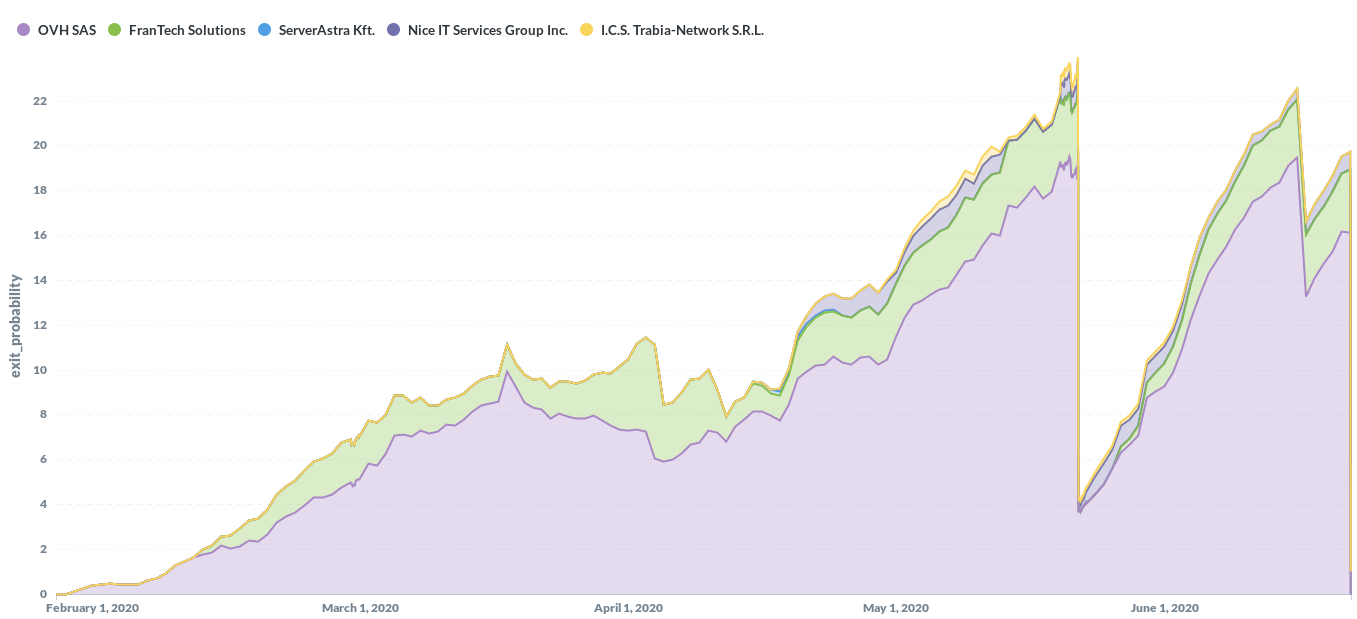In December 2019 I wrote about The Growing Problem of Malicious Relays on the Tor Network with the motivation to rise awareness and to improve the situation over time. Unfortunately instead of improving, things have become even worse, specifically when it comes to malicious Tor exit relay activity.
Tor exit relays are the last hop in the chain of 3 relays and the only type of relay that gets to see the connection to the actual destination chosen by the Tor Browser user. The used protocol (i.e. http vs. https) by the user decides whether a malicious exit relay can actually see and manipulate the transferred content or not.
[…]
One key question of malicious relay analysis always is: What hosting companies did they use? So here is a break down by used internet service provider. It is mostly OVH (one of the — generally speaking — largest ISPs used for Tor relays). Frantech, ServerAstra and Trabia Network are also known providers for relays. “Nice IT Services Group” looks interesting, since I’ve never seen relays on this obscure network before the attacker added some of his relays there on 2020–04–16.
[…]
The full extend of their operations is unknown, but one motivation appears to be plain and simple: profit.
They perform person-in-the-middle attacks on Tor users by manipulating traffic as it flows through their exit relays. They (selectively) remove HTTP-to-HTTPS redirects to gain full access to plain unencrypted HTTP traffic without causing TLS certificate warnings. It is hard to detect for Tor Browser users that do not specifically look for the “https://” in the URL bar.[…]
There are established countermeasures, namely HSTS Preloading and HTTPS Everywhere, but in practice many website operators do not implement them and leave their users vulnerable to this kind of attack. This kind of attack is not specific to Tor Browser. Malicious relays are just used to gain access to user traffic. To make detection harder, the malicious entity did not attack all websites equally. It appears that they are primarily after cryptocurrency related websites — namely multiple bitcoin mixer services. They replaced bitcoin addresses in HTTP traffic to redirect transactions to their wallets instead of the user provided bitcoin address. Bitcoin address rewriting attacks are not new, but the scale of their operations is. It is not possible to determine if they engage in other types of attacks.
[…]
Summary
- Since the disclosure of large scale attacks on the Tor network (malicious operator did run >10% of Tor’s guard capacity) in December 2019, no improvements with regards to malicious Tor relays have been implemented.
- The malicious Tor relay operator discussed in this blog post controlled over 23% of the entire Tor network exit capacity (as of 2020–05–22)
- The malicious operator demonstrated to recover their capacity after initial removal attempts by Tor directory authorities.
- There are multiple indicators that suggest that the attacker still runs >10% of the Tor network exit capacity (as of 2020–08–08)
- The reoccurring events of large scale malicious Tor relay operations make it clear that current checks and approaches for bad-relays detection are insufficient to prevent such events from reoccurring and that the threat landscape for Tor users has changed.
- Multiple specific countermeasures have been proposed to tackle the ongoing issue of malicious relay capacity.
- It is up to the Tor Project and the Tor directory authorities to act to prevent further harm to Tor users.
- […]
Source: How Malicious Tor Relays are Exploiting Users in 2020 (Part I) | by nusenu | Aug, 2020 | Medium

Robin Edgar
Organisational Structures | Technology and Science | Military, IT and Lifestyle consultancy | Social, Broadcast & Cross Media | Flying aircraft

